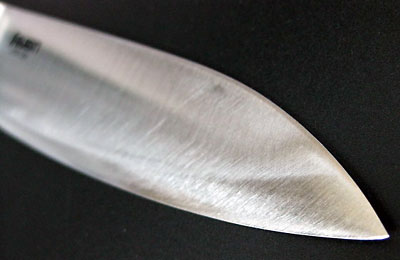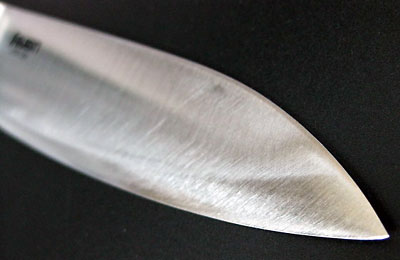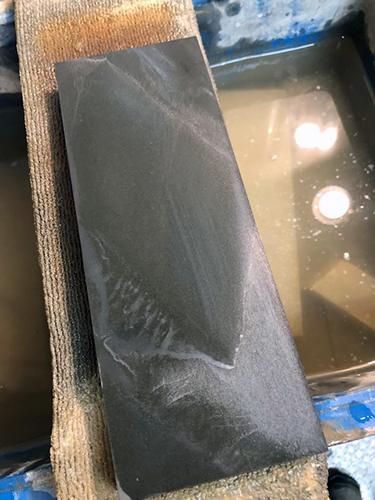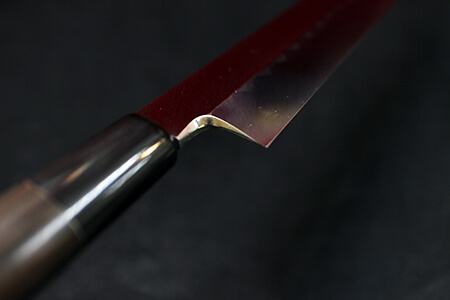Customizing Your Chef’s Knife: Perfecting the Tip for Precision Slicing

My trusty chef’s knife has been feeling a bit sluggish lately. Yep, talking like a real chef here… When you keep sharpening while trying to maintain the original edge, the blade starts to get thicker. A thicker blade can lead to poor slicing performance, and it feels like the thickness interferes with the cutting action before the actual edge engages with the ingredients.
So, how do we fix this? Well, let’s buy a new knife! (Just kidding, that’s a rather business-minded solution, isn’t it?) Okay, let’s move on to the real solution.
To resolve this issue, you need to thin out the blade. You’re not actually sharpening the part that does the cutting; instead, you’re sharpening the entire blade that moves through the ingredients.

This is a photo of the blade after sharpening with a coarse whetstone. It’s a double-edged chef’s knife, but I’m sharpening only one side. The reason I’m widening the edge with the tip is to aim for better slicing performance. Now, I know it might sound strange to talk about ‘slicing’ with a Western-style knife since they’re typically used for chopping, but bear with me; I’m applying a bit of my Japanese-style sharpening sensibilities here. Western knives generally have lower hardness overall, so if you thin them out too much, the edge can become weak. It might start feeling ‘wobbly,’ if that makes sense.
So, a ‘Hamaguri’ style edge, where we leave some thickness on the blade while sharpening, becomes necessary. Yep, this is where the magic of sharpening lies. While the blade of this knife is still quite wide, if it narrows further, I’ll have to sharpen all the way to the tip. Of course, this means that any brand names, prints, or engravings on the blade will disappear!
Now, from this point, you might wonder: should I use a medium whetstone or just sharpen the tip with a finishing stone? The final touches depend on your preference. But if you make it super shiny, food might stick to it. If you do want that shine, you can try creating a stronger ‘Hamaguri’ and aim for better separation. However, since the blade of a chef’s knife is inherently thick, the Hamaguri effect might not be that pronounced. Sometimes, no matter what you do, ingredients still stick.
So, does the Hamaguri edge serve no purpose then? Well, not exactly. It serves two purposes: to maintain edge thinness while preserving strength and to provide a slight separation. Whether it works perfectly can only be confirmed during actual use.
You might wonder if it loses its meaning altogether. However, I find it fascinating to sharpen while considering these aspects. If you manage to get everything right, you end up with a formidable tool, customized to your liking. Having a unique tool is great, but mastering a common one better than others can be equally satisfying. Sharpening is a bit like customizing a car; it’s your chance to make it uniquely yours.
Perhaps this is why many men are drawn to knives and similar tools. There’s something about the process that’s truly captivating.
hibishugyo
- 2010-04-13





